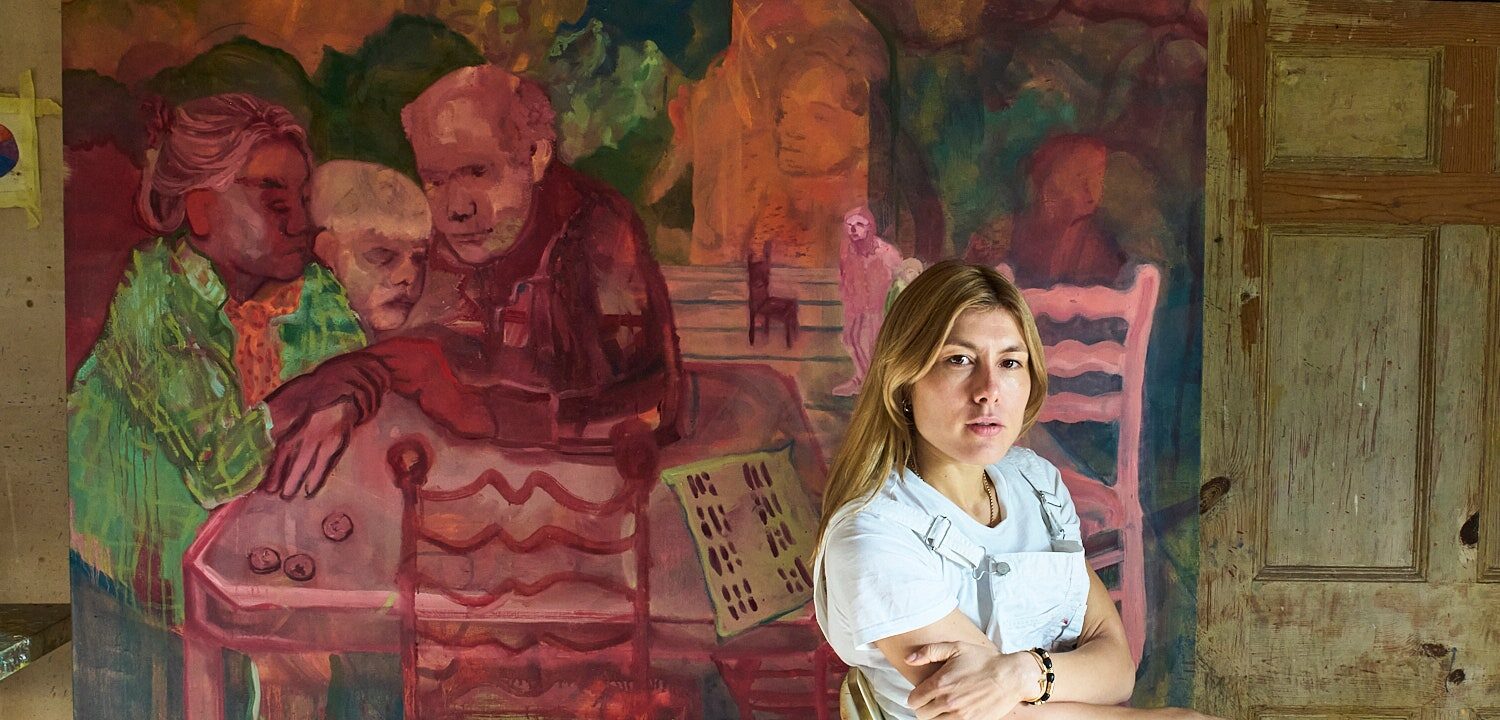The term pentimento comes from the Italian pentirsi, meaning “to repent.” In art, it refers to the faint traces of an earlier composition that remain visible after an artist revises or covers up part of their work. Picasso left hints of a woman’s face behind the central figure in The Old Guitarist, and John Singer Sargent adjusted the shoulder strap in his famous Madame X portrait after its original placement—sliding down the arm—sparked controversy at the 1884 Paris Salon.
For British artist Antonia Showering, however, pentimento isn’t just an occasional fix—it’s a fundamental part of her process. She layers loose, dreamlike depictions of people and places, some real and some imagined, one over another. Figures blur into landscapes; sharp lines dissolve. Sometimes she’ll wash the entire canvas in ochre or green and begin again. These remnants of earlier choices aren’t mistakes—they’re essential, what she calls “evidence of the journey that led me to the finished piece,” as she explained during a recent lecture at the New York Studio School.
The ghostly layers in her work reflect her central themes: time and memory. Life’s most intense moments—joy, grief—fade with time but never completely disappear, much like the underpaintings in her art.
The past three years have been full of such moments for Showering: the birth of her child, a breakup, the loss of both grandmothers, and a move from London to rural Somerset. “It’s been an emotionally charged time, watching my family shift and everyone moving forward in life’s cycle,” she tells me as we sit in a sunlit room at Timothy Taylor gallery in Tribeca, where her new solo show, In Line, opens May 8. This exhibition—her first in the U.S., her first as a mother, and her most personal yet—features 13 oil paintings created during this turbulent period.
In The Waiting Room (2025), reminiscent of Alice Neel’s work, Showering paints a nude woman on a bed, connected to a baby by an umbilical cord. The woman’s gaze is downcast, her belly still full. The baby—perhaps just born, or maybe a symbol of the responsibilities of parenthood—is washed in pale white. Through a window, a group of figures stands in the distance. “I knew the story I wanted to tell,” she says. Painting allowed her to capture emotional complexity in a way words never could. “Language can be slippery—we all interpret abstract words like intimacy or worry differently, based on our own experiences.”
While The Waiting Room had a clear vision from the start, other works reveal themselves gradually. For 5L (2024), she began by pouring oil paint onto a canvas laid flat on the floor. Once dry and upright, the painting took unexpected turns. Maybe it wasn’t about parenthood, as she first thought. Maybe the shape in the foreground wasn’t a table but a bed. “Then, through this unplanned play, I noticed the same figure here,” she says, pointing to an orange orb at the top that mirrors an orange figure below. “Completely accidental—like an energy, or a soul escaping.” Her maternal grandmother, a major influence who taught art history and attended all of Showering’s exhibitions, had recently passed away. “Maybe it was subconscious, or maybe it wasn’t. Oil paint has a kind of magic to it.”
And so here she is, caught between two extremes: becoming a caregiver and losing one. “When you…”Here’s a natural, fluent rewrite of the text while preserving its meaning:
—
Facing that moment feels extraordinary, yet it’s simply part of life’s cycle—one of the most ordinary things there is.
An installation view of “In Line” shows works including Gentle Hands, Master Key, and The Waiting Room (left to right).
Born in London in 1991, Antonia Showering traces her love of art back to childhood. She learned to draw from her architect grandfather and later studied at the City & Guilds of London Art School and the Slade School of Art, earning her master’s in 2018. Since then, her career has risen quickly. That same year, she received the New Contemporaries x SPACE Studio Bursary Award and has since held solo shows at Timothy Taylor’s London gallery (2022) and White Cube (2020). Her work has also appeared in group exhibitions at Whitechapel, Hauser & Wirth, and Kasmin (curated by her friend Katy Hessel). Her pieces are now part of collections at the New Orleans Museum of Art and the British Museum.
Recently, Showering moved from London to the peaceful countryside of Somerset, where she grew up. The change has been productive. “My studio is so remote that the only sounds are the moos of escaped cows,” she says—a stark contrast to her years in London, where she could hear a neighbor turning a newspaper through the walls and where “every corner started to feel like a graveyard of memories.”
Much of her childhood was also spent in her grandmother’s Swiss hometown, a place she still visits often. The dramatic mountain landscapes there have long influenced her work. “Those mountains have always been an anchor. Life changes, but they stay the same,” she reflects. While preparing for a lecture, she rediscovered old sketchbooks from age 10, filled with drawings of family and relationships set against those same Swiss peaks.
“In Line” explores life in all its messy beauty. While it carries the surreal, symbolic touches of her past work, Showering delves deeper here, capturing the intensity of this phase of life. “I’ve been trying to slow down time and make sense of moments and feelings I know are universal,” she says. Longing, grief, serenity, love—these deeply human emotions suit her psychologically charged style. Her art feels like trying to describe a dream: vivid details blur, becoming illegible beneath layers. But perhaps that’s the point—some things are clearer when slightly out of focus.
“Antonia Showering: In Line” runs at Timothy Taylor in New York City from May 8 to June 21, 2025.
—
(Note: The original text had some formatting and special characters that may not have translated perfectly, but the meaning remains intact.)


